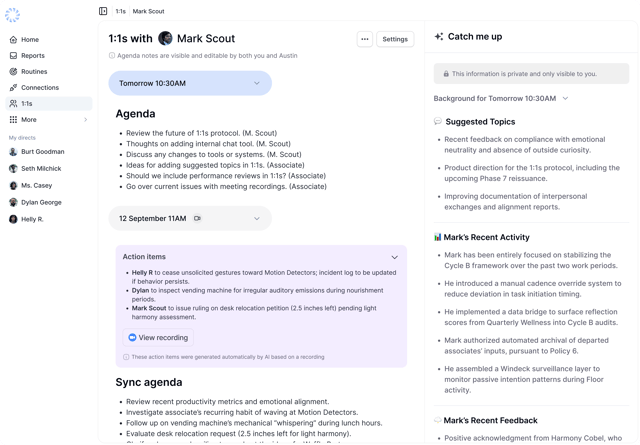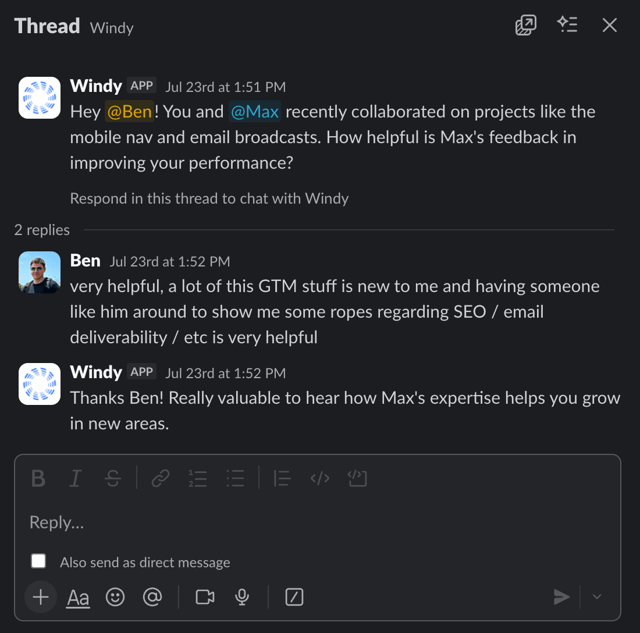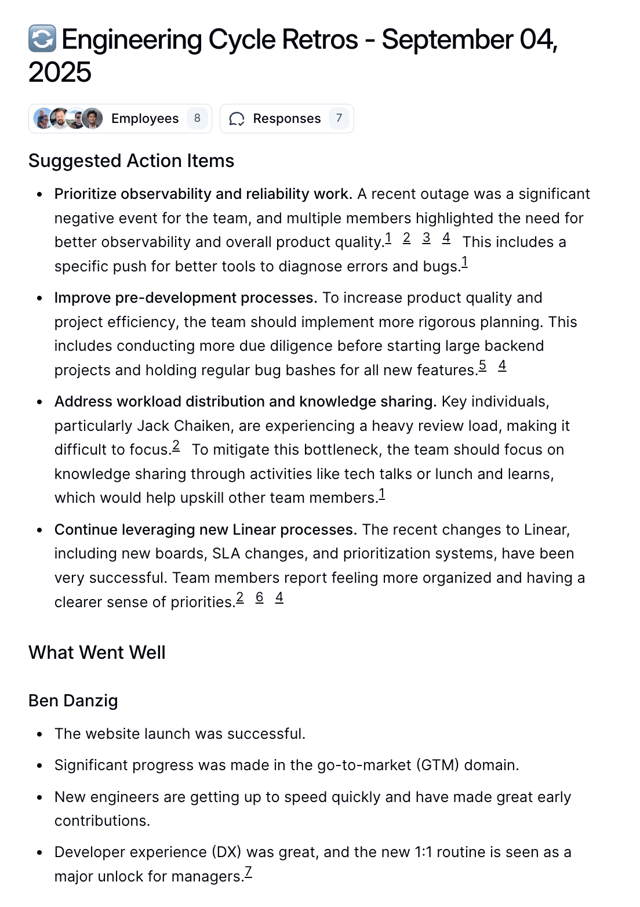10 Ways Windy Transforms People Management with AI
Discover how Windy, an AI assistant for people management, automates performance reviews, 1:1s, feedback, and goal tracking—saving managers 210+ hours per year.
People management is broken. Managers spend five full weeks per year on performance reviews alone. Add in preparing for 1:1s, tracking goals, gathering feedback, and running team check-ins, and the administrative burden becomes overwhelming.
Traditional people management tools like Lattice, 15Five, and Culture Amp try to help, but they’re still just dashboards and forms that require constant manual input. The result? Managers spend more time updating systems than actually managing their teams.
Enter AI for people management. With 77% of businesses now integrating AI into their operations, the way we manage teams is fundamentally changing. But not all AI solutions are created equal.
Meet Windy, an autonomous AI that lives in Slack and automates every aspect of people management—from performance reviews to goal tracking to continuous feedback. By syncing with your existing business tools and having natural conversations with your team, Windy eliminates the administrative overhead that bogs down modern management.
Here are 10 ways Windy is transforming people management with AI.
1. Automates Performance Reviews with Year-Round Context
Performance reviews are the most dreaded ritual in corporate life. Managers scramble to remember what their direct reports accomplished months ago, employees struggle to articulate their wins, and HR teams spend weeks chasing people down to complete reviews.
How Windy Works: Throughout the year, Windy syncs with 20+ business tools—GitHub, Linear, Asana, Figma, Notion, Airtable, Salesforce, Front, Gong, and more—to track what every employee is working on. When review time comes, Windy already has 90% of the context.
For self-reviews, Windy pulls in work data and creates a conversational guide in Slack to help employees remember their accomplishments. For peer reviews, Windy suggests relevant colleagues based on who you’ve actually worked with, then collects their feedback conversationally. For manager reviews, Windy identifies key wins and development areas, creating editable drafts that managers can refine.
The Results: Companies using Windmill for performance reviews dramatically reduce time spent on reviews—from hours of manual work to a streamlined process.
Instead of staring at a blank page trying to recall what happened in Q2, managers now have comprehensive, data-backed reviews at their fingertips.
2. Generates Personalized 1:1 Agendas Automatically
Most 1:1s start with awkward silence—“So, how’s everything going?”—and end with forgotten action items. Managers waste the first 10 minutes figuring out what to talk about, and important topics slip through the cracks.
How Windy Works: Throughout the week, just message Windy in Slack whenever something comes up—questions, feedback, wins—and it automatically gets added to your next 1:1 agenda. Before each 1:1 meeting, Windy checks in with your direct reports to gather what they want to discuss, pulls context from your business tools and past meetings, and creates a comprehensive agenda.
The Results: No more scrambling for topics. Managers walk into 1:1s with everything they need for a productive conversation—recent work updates, outstanding action items, and discussion topics from both sides.

3. Tracks Goals and Flags At-Risk Priorities Automatically
Goals get set in January and forgotten by March. Without consistent tracking, even the best intentions fall through the cracks. Traditional goal-tracking systems require manual updates that nobody has time for.
How Windy Works: Windy monitors progress across your team by analyzing activity in your business tools and checking in through Slack with quick, conversational prompts. It tracks goals automatically and flags at-risk objectives before they become problems—so you can step in early without running another check-in meeting.
The Results: Goals stay top of mind, and teams stay focused. Windy’s lightweight check-ins serve as gentle nudges that keep progress moving without creating additional administrative work.
4. Gathers Continuous Feedback That’s Actually Honest
Today’s HR systems don’t help managers foster meaningful feedback cultures. Traditional feedback surveys through tools like Lattice are often disruptive, and the feedback itself is typically shallow—“roses and rainbows” instead of constructive insights.
How Windy Works: With Windmill’s Continuous Feedback feature, Windy has natural conversations with employees in Slack to gather honest, constructive feedback throughout the year. The conversational approach makes it feel less like a formal survey and more like a trusted colleague asking for your thoughts.
The Results: Companies see dramatically richer feedback. Research shows conversational AI surveys achieve 70-90% completion rates compared to just 10-30% for traditional surveys, and deliver 8x richer responses.
Avi saw his team go from vague one-liner feedback comments to paragraphs of insight—all without slowing down work or disrupting schedules.

5. Runs Pulse Checks That People Actually Complete
Traditional pulse surveys are a ton of work and don’t give actionable insights. They’re sent at inconvenient times, feel impersonal, and typically see abysmal response rates.
How Windy Works: Instead of a long structured survey, Windy chats with your team conversationally in Slack to understand sentiment, gather feedback after key changes (like a reorg), and identify issues before they escalate. You tell Windy what you want to know, and it automatically generates questions and collects responses.
The Results: Companies see 80%+ response rates and get results in hours, not weeks.
Windy generates a report with insights and a specific list of action items—not just raw data to decipher.
6. Transforms Sprint Retros from Time Sink to Growth Engine
Most retrospectives start late, lack preparation, and end without clear follow-through. Teams either can’t remember what happened during the sprint or spend the entire meeting rehashing issues without solutions.
How Windy Works: Before your retro meeting, Windy chats with your team async to gather input. It helps jog memories with suggested topics based on recent work and previous retros. Then Windy creates a structured report with the most important discussion topics—complete with context, quotes, and suggested solutions.
The Results: You walk into retros with clear themes, real examples, and no time wasted figuring out what’s worth discussing. With a running record of previous feedback, Windy ensures past issues don’t get forgotten.

7. Delivers Weekly Recaps Without Anyone Asking
Managers need to know what their teams are working on, but asking for updates feels like micromanagement. Meanwhile, CEOs and executives lack visibility into what’s happening across the organization.
How Windy Works: Windy generates weekly recaps by analyzing activity across all your integrated business tools—pull requests, Jira tickets, Salesforce deals, Google Docs, Slack conversations, and more. It creates comprehensive reports showing what each person accomplished, what they’re working on, and what’s blocked.
The Results: Leadership gets a clear picture of organizational activity without disrupting work.
8. Aligns Team Priorities Before Work Starts
When everyone works on different things without alignment, you get duplicated effort, conflicting priorities, and work heading in the wrong direction. But scheduling another alignment meeting just adds to meeting fatigue.
How Windy Works: Each Monday, Windy chats with your team in Slack to understand what everyone is focused on. Then it delivers insights highlighting conflicts, overlaps, and gaps—so managers can realign fast without calling a meeting.
The Results: Teams stay aligned with minimal overhead. Everyone knows they’re working on the right things.
9. Surfaces Blockers Before They Slow Work Down
Issues often go unnoticed until they snowball. By the time a manager sees a problem, it’s already affecting output, morale, or retention.
How Windy Works: Windy checks in with your team every week to collect blockers and delivers a clear report so you can take action before work slows down. Instead of waiting for someone to raise their hand in a meeting (which they often don’t), Windy proactively surfaces what’s getting in the way.
The Results: Blockers become a structured part of leadership workflows, allowing teams to spot and solve issues rapidly.
10. Lives Where Your Team Already Works: Slack
The biggest problem with traditional HR and people management tools is that they’re separate platforms nobody wants to log into. Managers already juggle dozens of tools—adding another dashboard just creates more work.
How Windy Works: Windy lives directly in Slack, where your team already communicates. Instead of forcing people to log into yet another platform, Windy comes to them. It integrates with 20+ existing business tools—from Asana and Monday to Salesforce and Hubspot to GitHub and Figma—to automatically gather context about what everyone is working on.
Every interaction with Windy uses state-of-the-art large language models to feel natural, flexible, and conversational. Windy doesn’t just send surveys—it has real conversations that adapt based on responses and dive into the details when needed.
The Results: Dramatically higher engagement. Companies using Windy see response rates of 80%+ compared to traditional survey tools where response rates have fallen to under 5%.
Why AI for People Management Matters Now
The data is clear: AI is transforming how companies operate. Over 70% of business leaders report significant productivity boosts from AI adoption, and AI has reduced time on key HR tasks by 40%.
But AI for people management isn’t just about efficiency—it’s about making management better. When managers spend less time on administrative tasks, they have more time for the work that actually matters: coaching their teams, solving problems, and building culture.
Traditional performance management tools like Lattice, 15Five, and Culture Amp digitized old processes, turning paper forms into web forms. Windy represents something fundamentally different: an AI teammate that proactively gathers context, has natural conversations with your team, and generates insights automatically.
How Windy Works: The Technical Details
Windy is built on three core capabilities:
1. Deep Integrations: Windy connects to your business tools to understand what every employee is working on. It analyzes pull requests, Jira tickets, Salesforce activities, Google Docs edits, Slack conversations, and calendar meetings to build a comprehensive picture of work across your organization.
2. Conversational AI: Using state-of-the-art large language models, Windy has natural conversations with employees in Slack. These aren’t rigid surveys—Windy adapts its questions based on responses, asks follow-ups, and can dive deep when needed. This is why companies see 80%+ response rates instead of the 10-30% typical of traditional tools.
3. Automated Insights: Windy doesn’t just collect data—it analyzes it. Using organizational network analysis, Windy understands who collaborates with whom, identifies patterns in team dynamics, and surfaces insights that would be impossible to spot manually.
The combination means managers get data-backed insights without any manual work. As one manager at Rho put it:
Getting Started with Windy
Setting up Windy takes minutes, not weeks:
- Connect to Slack: Add Windy to your Slack workspace
- Integrate Your Tools: Connect the business tools your team uses (see all integrations)
- Choose Your Routines: Pick which management tasks you want to automate (1:1s, performance reviews, feedback, etc.)
- Let Windy Run: Windy starts gathering context and chatting with your team automatically
Companies like Rho, Marqii, and Aura have transformed their people management in weeks, not months.
The Future of People Management is Conversational
The traditional approach to people management—manual performance reviews, disconnected feedback surveys, forgotten goals, poorly prepared 1:1s—doesn’t scale. Managers are drowning in administrative work, spending over 200 hours annually on performance management alone.
AI for people management changes the equation. With Windy handling the administrative heavy lifting, managers can focus on what they do best: supporting their teams, solving problems, and building great cultures.
The results speak for themselves: Performance reviews that take minutes instead of hours. 80% survey response rates instead of 10%. Continuous feedback instead of annual check-ins. Automated 1:1 agendas instead of awkward silences.
Ready to see how Windy can transform your people management? Visit gowindmill.com to learn more and get started.